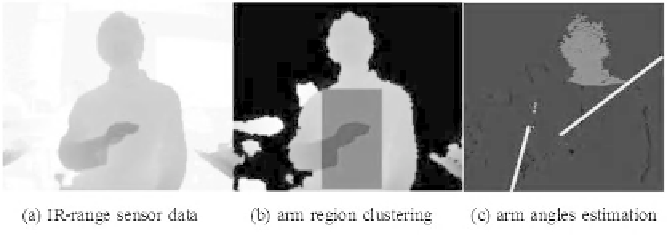Information Technology Reference
In-Depth Information
lower arm clusters. When both of the arms are placed out of the trunk region,
the vertical widths of scattered parts of the measured object are used as the
input features for a clustering technique to segment into the arms region out of
the trunk. The outline of the lower arms is then detected by searching voxel data
of the arm clusters out of the trunk region. Finally, detected voxels of the lower
arm outlines are used as the input features for a straight-line approximation of
lower arm angles.
Fig. 5.
An example of arm angles estimation
Figure 5 shows an example of an arm angles estimation; (a) shows the IR-
range sensor data, (b) shows the result of arm region clustering when either
arm is placed in front of the trunk and (c) shows the result of the arm angles
estimation. In (b), the dark gray region indicates a right arm region. This means
that we could correctly segment the trunk region and the arm region. In (c),
two white lines indicate upper and lower arm angles. This means that we could
correctly estimate the arm angles.
5 Discussions
5.1 The Concepts to Capture Gaze Directions, Facial Expressions
and Hand Gestures
In this section, we discuss the concepts to capture gaze directions, facial ex-
pressions and hand gestures. We expect that these are needed for investigations
about cultural differences.
Gaze direction.
The first author developed a real-time system for measuring
gaze directions without head restraint [11]. The system could measure gaze di-
rections in a small space (30cm high, 30cm wide and 20cm depth) because stereo
cameras could measure in the small space.
By using IR-range sensors, we can obtain many 3D positions and the rough
textureoffaceinrealtime(Figure6).Wecanthusimprovethesystemwithsame
accuracy (approximately
2 degrees) in larger space by using both IR-range
sensors and cameras. The system can be used for CEBE.
±

